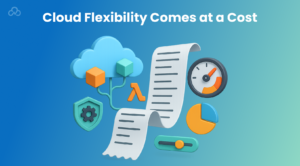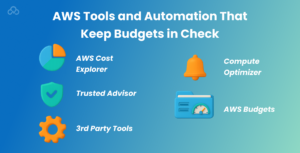Introduction

Cloud gives you options. Too many, sometimes. It starts simple, you spin up a few services, test out a new feature, maybe duplicate an environment “just for now.” Fast forward three months, and suddenly your AWS bill reads like a shopping list for a startup with no brakes. Seen it before? You’re not alone. The flexibility of AWS is both its biggest strength and its most expensive risk. Teams move fast, deploy faster, but forget to check if half their stack is still idling at 2 a.m. This is where aws cost optimization best practices stop being “nice to have” and start becoming survival tools.
And while AWS offers detailed billing tools and granular pricing, visibility isn’t the same as optimization. You still need strategy. Structure. Daily habits. For most orgs, that’s where AWS consulting services step in, to plug the cost leaks before they become budget disasters.
This guide breaks down the real-world tactics, decisions, and tools that help engineering teams and ops leads build smarter on AWS architecture without constantly fighting surprise invoices.
Why AWS Cost Optimization Is Not Optional (Anymore)
Here’s the thing with AWS: you don’t get billed for what you need. You get billed for what you leave running, and maybe also whatever someone forgot to shut off three sprints ago.
In theory, that’s the beauty of cloud. Pay-as-you-go. Scale up, scale down, respond to real-time traffic. Sounds perfect.
But reality? Teams are moving fast. Pushing features. Testing things in staging, spinning up resources “just for now”, and then never going back to clean up. That idle staging cluster? Still billing. That unused 2TB EBS volume? Yeah, also still billing.
If you’re working with layered AWS architecture, dev, test, staging, prod, this creeps up quickly. The default instinct is to overprovision just to be safe. And no one wants to be the person who accidentally under-provisioned the production DB. So we overcompensate.
Problem is, nobody goes back and rightsizes. Which is why aws cost optimization best practices are no longer a luxury, they’re part of staying lean and operationally sane. Even small oversights compound at scale. What seems like “just a few bucks” today turns into thousands a quarter when you’re dealing with 50+ services across teams.
According to Flexera’s 2024 report, 28% of cloud spend is wasted. That’s not theoretical. That’s real, recurring spend for resources nobody’s even using.
And here’s the worst part: the longer you ignore it, the harder it is to fix. You’ll be three quarters deep into waste before you realize half your infrastructure hasn’t been touched since onboarding.
That’s where many companies lean on AWS consulting services to audit their usage, plug the holes, and build cost-awareness into their workflows, before the invoice becomes the fire alarm.
Six AWS Cost Optimization Best Practices That Actually Work
There’s no universal fix when it comes to cloud spend. But these six tactics? They keep showing up across industries, especially in companies running large-scale AWS services for web apps.
They’re practical. Repeatable. And more importantly? They work.
1. Stop Overbuilding Your Instances
You think you need that m5.4xlarge. Until you realize the CPU usage barely hits 20%. Most workloads are overbuilt by default. Use AWS Compute Optimizer or CloudWatch metrics, and let the data shame your assumptions. Seriously, rightsizing is the easiest win.
2. Tag Your Stuff or Regret It Later
No one loves tagging. But if you skip it? Good luck figuring out what test-eks-prod-clone2 belongs to next month. Tags like Project, Owner, and Environment make reporting, chargebacks, and cleanup 10x easier. It’s annoying now, but trust, it saves hours later.
3. Don’t Let Things Idle
Auto Scaling Groups and Elastic Load Balancers aren’t optional anymore. If your web apps live on EC2 or ECS, scale based on demand and shut things down when traffic dips. Spiky workloads? Use dynamic scaling. It’s one of the most overlooked aws cost optimization best practices out there.
4. Use Reserved Instances or Savings Plans (Yes, Actually)
It’s boring advice, but it’s still gold. If your services run 24/7, locking into Reserved Instances or Savings Plans cuts costs dramatically, up to 72% compared to On-Demand. And no, you don’t have to guess. AWS will show you your usage baseline. Just look at it.
5. Offload to Managed Services Where You Can
If you’re running basic backend jobs or web apps on EC2, pause. Can Lambda or Fargate do it better? Probably. These managed services scale automatically and only bill when in use. That’s a major shift in cost model. And yeah, Aurora Serverless? Not perfect, but better than paying for idle MySQL.
6. Get External Eyes on Your Setup
A lot of internal teams just don’t have the time, or the context, to do full cost audits. That’s where a managed DevOps service or solid AWS consulting services come in. They’ll identify zombie resources, underused savings plans, or even architectural bottlenecks you never spotted. External audits might seem costly upfront, but the long-term savings usually cover that cost within weeks.
Apply these aws cost optimization best practices consistently, not as an end-of-quarter checklist, but as part of your workflow. That’s how you keep cloud spend from spiraling. One habit at a time.
AWS Tools and Automation That Keep Budgets in Check

Optimizing costs manually? That doesn’t scale. Even small teams need help staying ahead of drift.
AWS does offer solid tooling, some better than others. Here’s what’s actually useful when you’re trying to keep spending under control without babysitting every service.
- AWS Cost Explorer
The basics. Visualize spend by service, tag, or account. Good for spotting sudden spikes or forgotten resources.
- AWS Budgets
Set soft or hard thresholds on forecasted spend. You’ll get alerts before you blow past the number, assuming alerts are actually read.
- Trusted Advisor
If you have Business or Enterprise support, this tool gives real-time recommendations on cost, security, and performance. Not perfect, but it’ll catch low-hanging fruit.
- Compute Optimizer
Surprisingly underrated. If you’re still guessing instance sizes, this will give you data-backed recommendations to rightsize your fleet.
- 3rd Party Tools
If you’re juggling multi-cloud or need deeper FinOps controls, tools like CloudHealth, Spot.io, or Harness offer more granularity and policy enforcement.
Also worth noting: teams working with a managed DevOps service often get these tools integrated directly into their delivery pipelines, so cost checks happen before infra goes live.
Case Study: When Optimization Actually Worked
Let’s say you’re running a mid-sized ecommerce platform on AWS. You’ve got EC2 for your frontend, RDS for orders, and some Lambda functions for background jobs.
Over the span of six months, traffic grows. So do the costs. At first, no one panics. But by month seven, you’re spending 3x your original budget, and nobody knows what changed.
Here’s what a basic cost audit found:
-
3 EC2 instances running at 8% average CPU.
-
1 RDS instance still in db.m5.large when db.t3.medium would’ve sufficed.
-
Test environments with no TTL (time-to-live) policies.
-
Snapshots from three quarters ago still incurring storage costs.
After applying just three aws cost optimization best practices, rightsizing, turning on auto-scaling, and tagging environments for cleanup, the monthly AWS spend dropped by 41%. No loss in performance. No rebuild. Just better hygiene.
It wasn’t rocket science. It was mostly stuff that got missed while everyone was busy shipping.
Balancing Performance with Budget (Without Breaking Stuff)
Cutting costs is important. Killing reliability in the process? Not worth it.
A big part of optimization isn’t technical, it’s strategic. You need to know where it’s okay to trim and where it’s not.
For example:
-
Don’t downsize production databases if you haven’t tested under load.
-
Don’t use spot instances for core web traffic, unless your team can handle sudden preemptions.
-
Don’t rely on Lambda for latency-sensitive backend unless cold starts have been benchmarked.
Instead, ask:
-
Can we move this job to run on-demand instead of hourly?
-
Can dev environments auto-suspend after 6 p.m.?
-
Can we use S3 Intelligent-Tiering for old logs?
These small changes, stacked together, deliver meaningful savings. Especially for teams managing AWS services for web apps across multiple environments.
Conclusion: Optimization Isn’t One-Off, it’s Ongoing
Most AWS bills don’t explode overnight. They balloon over time, quietly, line by line.
That’s why aws cost optimization best practices aren’t just ops tasks. They’re team-wide habits. From engineers to product managers, everyone needs visibility into what’s running and what it costs.
The good news? With the right mix of automation, awareness, and support, whether internal or via AWS consulting services, costs become predictable. Manageable. Even strategic.
But it starts with asking a simple question: “Do we really need all of this running right now?”
Technical FAQs
Q1: How often should I run a cost audit on my AWS account?
Monthly is a good baseline. Weekly for fast-moving teams. Automation via Budgets or Cost Explorer alerts helps keep you ahead of surprises.
Q2: What AWS services are easiest to overspend on?
EC2, EBS, and RDS top the list. Especially when autoscaling isn’t configured properly or dev environments are always-on.
Q3: How do AWS consulting services help with cost optimization?
They bring outside perspective, identify misconfigurations, recommend better service choices, and help design sustainable AWS architecture. Many also automate parts of FinOps.
Q4: Can I combine cost optimization with performance tuning?
Yes, and you should. Optimization isn’t just about cutting, it’s about aligning spend with performance needs. A well-optimized app runs smoother and cheaper.
Do you like to read more educational content? Read our blogs at Cloudastra Technologies or contact us for business enquiry at Cloudastra Contact Us